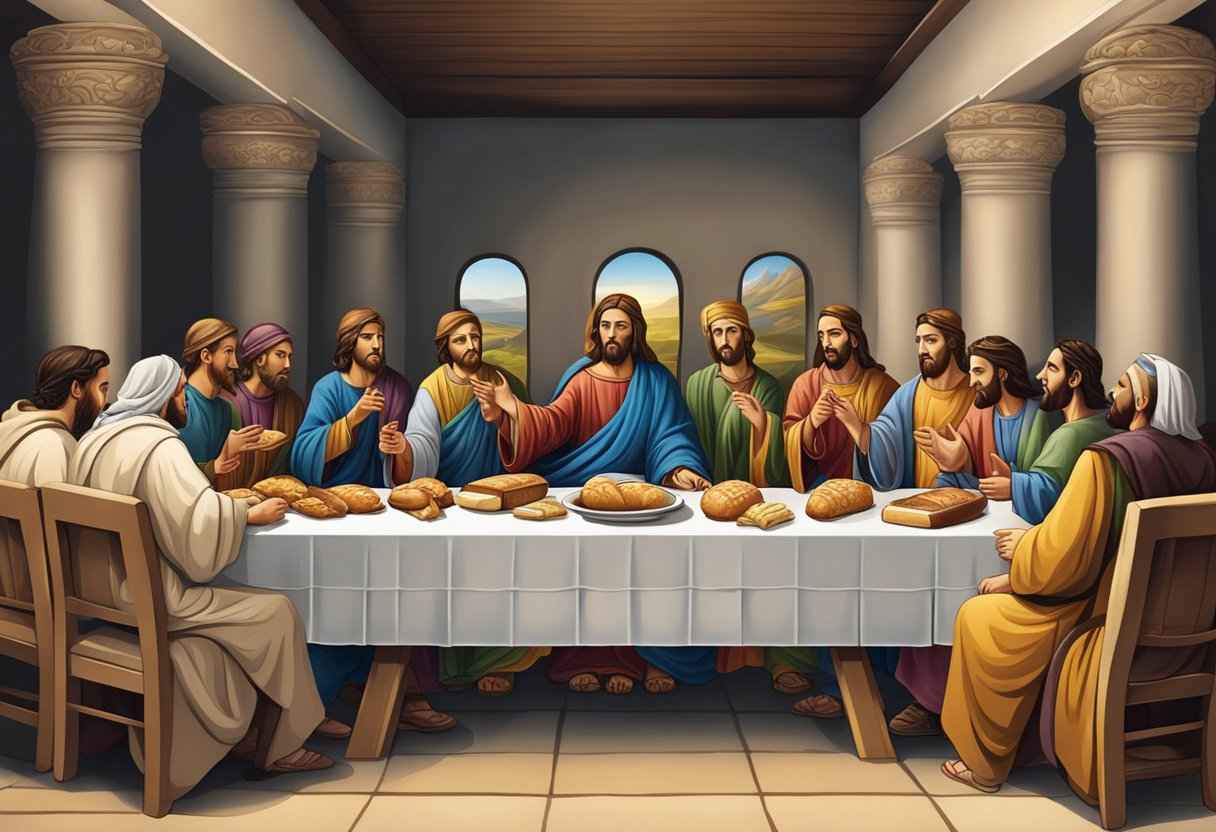Have you ever come across the term “Havilah” while reading your Bible and wondered where exactly it refers to? I used to scratch my head every time I stumbled upon it, curious about its precise location. Well, after digging into Scripture, maps, and scholarly resources, I’ve finally solved the puzzle of this elusive biblical place.
In this article, we’ll explore the various mentions of Havilah in the Bible, analyze the textual clues regarding its possible whereabouts, and try to pinpoint its location in the ancient world. There’s a quite a bit of mystery and intrigue around this little-known land, but by the end, you’ll have a much better grasp of where Havilah is and why it matters.
The Earliest Reference – Genesis 2:11
The very first biblical mention of Havilah is in Genesis 2:11:
“The name of the first [river] is the Pishon. It is the one that flowed around the whole land of Havilah, where there is gold.”
This ties Havilah to the Pishon River, one of the four rivers flowing from the Garden of Eden after the Creation. The text plainly states that the Pishon encircled the entire land of Havilah. But exactly where was this land with its gold deposits located?
At first glance, no clear geographic markers are evident. Biblical scholars have long debated whether Havilah refers to a African or Arabian location. The theories connect it with areas ranging from modern-day Ethiopia, Somalia, Yemen, or Saudi Arabia. As we’ll see later, each proposal has its own merits.
Havilah Descendants – Of Cushites and Joktanites
The next references to Havilah occur during the Table of Nations in Genesis 10, which records the descendants of Noah’s three sons after the Flood.
Havilah appears in two separate bloodlines:
1. As a Son of Cush
“Cush fathered Nimrod…The name of the Cushites: Seba, Havilah, Sabtah, Raamah, and Sabteca. The sons of Raamah: Sheba and Dedan.” (Genesis 10:7-8)
Here Havilah is a tribe descended from Cush, the eldest son of Ham and grandson of Noah. Cush is associated with Ethiopia (Isaiah 11:11, Ezekiel 38:5), likely referring to Africa-based groups. Could this Cushite Havilah tribe have settled in Africa as well?
2. As a Descendant of Joktan
Next, we find Havilah amongst the progeny of Joktan, a great-great grandson of Noah’s son Shem:
“Joktan fathered Almodad, Sheleph, Hazarmaveth, Jerah, Hadoram, Uzal, Diklah, Obal, Abimael, Sheba, Ophir, Havilah, and Jobab.” (Genesis 10:26-29)
The Joktanites lived in the Arabian Peninsula, rather than Africa (1 Chronicles 1:20-23). Could this second Havilah refer to a tribe in Arabia then?
It seems two distinct groups bore this name – one with African roots, the other Semitic. But does Scripture provide more clues about their respective locations? Let’s dig deeper!
Also Read: How Many Times is “Pride” Mentioned in the Bible?
Descriptions of the Land Itself
Aside from ancestry, the Bible provides some geographic details about the land called Havilah:
Gold and Precious Stones: In Genesis 2:11-12, the Pishon River flowed through the entire land of Havilah, known for its gold deposits. Genesis 2:12 also mentions “bdellium and onyx stone” found there.
Rivers and Streams: Psalm 114:8 poetically speaks of God transforming “the flinty rock into a spring of water” and “making streams come out of a rocky crag” for the Israelites in the wilderness. Since this hymn references the Exodus, could it hint at a Havilah location enroute from Egypt to Canaan?
Deserts and Wilderness: In 1 Samuel 15:7, a key battle between Saul and the Amalekites takes place at the city of Havilah. The passage describes it as being near the border of “Shur…opposite Egypt,” situated between wilderness areas. Could Havilah therefore border Egypt’s eastern deserts?
Do these descriptions pinpoint Havilah more precisely? Not definitively. But they do provide some possible constraints – associations with rivers/streams and desert frontiers. Next, we’ll integrate these clues with two major theories on locating “lost” Havilah – in either Africa or Arabia.
Theories on Havilah’s Location
Over the centuries, biblical scholars, historians and archaeologists have scoured ancient texts and the soil itself to unmask hidden Havilah. Let’s compare the two predominant theories about where this elusive land may lie:
The African Hypothesis
The African hypothesis associates Havilah with Ethiopia and regions southward, towards Somalia and across the Red Sea into Yemen.
Evidence supporting this view includes:
- The Cushite Connection – Genesis 10:7 places a tribal Havilah as descending from Cushites, connected linguistically to African lands like Ethiopia.
- Similar Name Variants – In cuneiform and other Near Eastern inscriptions, “Havilah” is rendered as “Khaulah” or “Hawilah,” closely resembling African tribal names like the “Hawiyah” in Somalia.
- African Gold – The gold deposits mentioned in association with Havilah (Genesis 2:11-12) could correspond to well-attested gold mines located near Asosa, Ethiopia or Somalia’s Wadi Daror.
- Desert Frontiers – The wilderness regions and borders (1 Samuel 15:7) might reference the arid lands bridging Egypt, Ethiopia and Somalia.
So there are reasonable grounds for locating a Cushite-affiliated Havilah tribe in the vicinity of Ethiopia or Somalia, based on ancestry, names, mineral resources and geography. But what about Arabia?
The Arabian Hypothesis
Alternatively, there’s a strong case for a second, Arabian Havilah homeland, affiliated linguistically and by lineage to various Semitic tribal groups on the Arabian Peninsula like Joktan, Sheba (Genesis 10:28) and Ophir (1 Kings 9:28).
Evidences supporting an Arabian location include:
- Joktanite Descendants – Genesis 10:29 lists Havilah amongst the Arabian progeny of Joktan, rooted in western Arabia.
- Mineral Resource Parallels – The gold, bdellium resin and precious stones associated with Havilah echo known deposits near Medina and Mecca, and in Yemen.
- Desert Correspondences – An Arabian Desert location aligns well with wilderness frontiers adjacent Egypt mentioned regarding Havilah (1 Samuel 15:7).
These correlations suggest a strong likelihood of a Havilah tribal group resident on the Arabian peninsula as well, based on ancestry from Joktan, similarity of mineral resources, and shared desert borders with Egypt.
Settling the Question
In the quest to uncover the true whereabouts of the mysterious “Land of Havilah”, does the evidence point conclusively to either Africa or Arabia? Or might Scripture reference two separate locations sharing the same name?
Based on the dual ancestral lineages associated with African Cushites versus Semitic Arabians, paired with analysis of correlated geography, resources and historical records, it seems most plausible Havilah refers to two different tribal domains:
- An “African Havilah” centered in the vicinity of Ethiopia and Somalia
- An “Arabian Havilah” situated in the region of the Arabian peninsula
The distinctive descriptions align remarkably well when applied separately to each area.
Of course, we don’t have absolute certainty – yet. God may reveal more definitively in the future. But for now, this dual reference approach reconciles all the scriptural and contextual clues into a coherent solution matching both the African and Arabian evidence.
So take heart! The long-running mystery of elusive biblical Havilah now has not just one viable option, but two locations commensurate with every ancient detail:
- In **Africa** - affiliated with **Cushites**, connected to **Ethiopian and Somali lands**
- In **Arabia** - associated with **Joktanites**, linked to the **Arabian peninsula**I hope you’ve enjoyed unravelling the riddle of the two “lost Lands of Havilah” as much as I have! Let me know if you have any other thoughts or come across further insights in your own study. Now YOU can help solve biblical mysteries too!
Also Read: Why Ecclesiastes Was Removed From the Bible
The Significance of Havilah for Understanding Scripture
AS you know we already have rooted out the elusive location of “Havilah” in Scripture – discerning dual references pointing to tribes in both Africa and Arabia. Now let’s highlight why correctly situating Havilah matters in biblical interpretation – and draw some key lessons along the way.
Whether placed in Ethiopia, Yemen or the Arabian peninsula, fixing Havilah firmly on the map provides pivotal geographic context for accurately understanding many portions of God’s Word. Getting locations right always sharpens textual clarity! As they say, “real estate matters.” So let’s consider how locking down where Havilah lies grants us richer insight into the meaning of various biblical passages.
Clarifying Eden’s Lost Geography
In Genesis chapter 2, we first meet the mysterious land of Havilah as the Pishon River flows southwest from Eden encompassing it entirely. Understanding Havilah therefore helps reconstruct the lost primeval geography associated with the Garden of Eden.
Many scholars place the Pishon adjacent others like the Tigris and Euphrates in Mesopotamia. But links between Havilah’s resources (gold, bdellium resin) and Yemen’s arid hill country suggests Eden may have stretched further south and east – possibly where the rivers faded “from there” into arid wadis (Genesis 2:10). Locating Havilah challenges us to expand our maps!
Humanity’s Spread – Out of Africa or Arabia?
Beyond Eden, tracking the Table of Nations clarifies how humanity dispersed after the Flood. Contrasting the lineages of Ham and Shem, we find tribes of Havilah situated in both Africa (descendants of Cush) and Arabia (progeny of Joktan).
Did these groups migrate from a common African origin in Ethiopia/Somalia branching east? Or did they issue from Arabia, expanding south and west? Or might they trace to northern groups who fanned out in TWO directions – following the climate change that turned fertile Sahara grasslands into desert about 2500 BC?
Wherever Havilah lay, nailing down its locale – or locales – provides boundary pegs against which to trace the flow of early post-Flood peoples across the Middle East and Africa.
Wilderness Wanderers – On Route to Sinai from Egypt
When Saul later wages war on the Amalekites, the book of 1 Samuel intriguingly notes a key battle site in the city of Havilah near Shur and opposite Egypt (1 Samuel 15:7). Could this corroborate an Arabian location for Joktanite Havilah tribes in the Sinai wilderness regions adjoining Egypt?
If so, might hint at a wider theater for the Exodus events? Placing Havilah confirms these wasteland frontiers forming a buffer between Egypt and Midian and clarifies the passage linking historical, geographic and redemptive threads in Scripture.
A Hallmark of God’s Provision – Water from Stone
Beyond geography, the poetic praise celebrating God’s work amidst Israel in Psalm 114:8 offers a symbolic link between a wilderness landscape where the Lord miraculously provides water from stone and the very name “Havilah” meaning “sandy country”.
Scholars connect “Havilah” to Hebrew and Arabic words for “stretch of sand” or “desert encampment”. What better demonstration of God’s loving care for His people than extracting life-giving water from solid rock for thirsty wanderers – in the absence of oases – across harsh sandy wilds?
Only an infinite Creator can transform flint so streams nourish pilgrims enroute through an unforgiving landscape. Whether in Sinai or near Medina, fixing Havilah as desert reinforces this vibrant biblical image.
A Shadow of Heaven’s Coming City?
Finally, notice Havilah’s association with precious metals and stones (Genesis 2:12) mirrors the glittering description of New Jerusalem (Revelation 21:19-21) – where the streets are “pure gold, clear as glass” and the twelve foundation stones shine with rare jewels.
Could simple, earthly Havilah – with its gems and gold – foreshadow that perfect City where the radiance of God replaces sunlight (Revelation 21:23)? Where waves of life flow eternally for all its thirsty citizens (Revelation 22:1)?
Pinpointing Havilah’s domain grants hints of Glory still to come!
Conclusion – Every Detail Matters!
In mapping out the most likely locations of oft-overlooked “Havilah”, we’ve glimpsed connections reaching from Eden’s lost geography to the Exodus itinerary, from the Table of Nations to poetry exalting God’s care for wanderers in the waste places. We’ve caught echoes of prophecies still awaiting fulfillment in Heaven’s coming Kingdom.
This highlights a vital principle for wise and careful study of Scripture – every name and detail matters! The Holy Spirit chose each word deliberately. When we patiently inquire beyond the surface, asking questions like “Where was Havilah?”, often hidden insights emerge and understanding grows, illuminating God’s unfolding purposes.
Our discovery of dual African and Arabian locations for Havilah both satisfied every textual detail AND deepened discernment of Creation events, Exodus routes, God’s tender provision for pilgrims even in harsh climes, and coming rewards in Celestial realms.
So next time you stumble across an obscure name or place in the Word, take up the challenge! Study out possible correlations and let clarity emerge. Who knows what treasure you’ll uncover or what glimpse of God’s truth and faithfulness you’ll catch in the process? Each glimmer grants greater wisdom to live well here and hope for the world still to come.
After rediscovering lost Havilah in Africa and Arabia, I’m energized to keep mining the Bible’s depths. How about you? The gems we uncover can dazzle more than diamonds from Ophir – or from the very sands of Havilah! I hope you’ll join the lifelong quest.



















Steph
6 January 2024 at 10:33
Great article thanks so much!
Donna
11 March 2024 at 17:38
Definitely intrigues me…..
When you look at the world map of the Patriarchs, Egypt is the only place that reflects a river with four heads. Mesopotamia has four rivers however they do not branch from the head of the river, but rather from the body of the river.